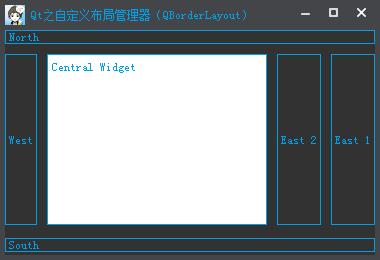Qt之自定义布局管理器(QBorderLayout)
Posted 一去丶二三里
tags:
篇首语:本文由小常识网(cha138.com)小编为大家整理,主要介绍了Qt之自定义布局管理器(QBorderLayout)相关的知识,希望对你有一定的参考价值。
简述
QBorderLayout,顾名思义-边框布局,实现了排列子控件包围中央区域的布局。
具体实现要求不再赘述,请参考前几节内容。
| 版权声明:一去、二三里,未经博主允许不得转载。
实现
QBorderLayout主要采用QLayout和QWidgetItem实现,而窗口使用了QWidget,中央窗体使用QTextBrowser,四周以QLabel排列。
效果

源码
QBorderLayout.h
#ifndef QBORDERLAYOUT_H
#define QBORDERLAYOUT_H
#include <QLayout>
#include <QRect>
class QBorderLayout : public QLayout
{
public:
enum Position {West, North, South, East, Center};
explicit QBorderLayout(QWidget *parent, int margin = 0, int spacing = -1);
QBorderLayout(int spacing = -1);
~QBorderLayout();
void addItem(QLayoutItem *item) Q_DECL_OVERRIDE;
void addWidget(QWidget *widget, Position position);
Qt::Orientations expandingDirections() const Q_DECL_OVERRIDE;
bool hasHeightForWidth() const Q_DECL_OVERRIDE;
int count() const Q_DECL_OVERRIDE;
QLayoutItem *itemAt(int index) const Q_DECL_OVERRIDE;
QSize minimumSize() const Q_DECL_OVERRIDE;
void setGeometry(const QRect &rect) Q_DECL_OVERRIDE;
QSize sizeHint() const Q_DECL_OVERRIDE;
QLayoutItem *takeAt(int index) Q_DECL_OVERRIDE;
void add(QLayoutItem *item, Position position);
private:
struct ItemWrapper
{
ItemWrapper(QLayoutItem *i, Position p) {
item = i;
position = p;
}
QLayoutItem *item;
Position position;
};
enum SizeType { MinimumSize, SizeHint };
QSize calculateSize(SizeType sizeType) const;
QList<ItemWrapper *> list;
};
#endif // QBORDERLAYOUT_HQBorderLayout.cpp
#include "QBorderLayout.h"
QBorderLayout::QBorderLayout(QWidget *parent, int margin, int spacing)
: QLayout(parent)
{
setMargin(margin);
setSpacing(spacing);
}
QBorderLayout::QBorderLayout(int spacing)
{
setSpacing(spacing);
}
QBorderLayout::~QBorderLayout()
{
QLayoutItem *l;
while ((l = takeAt(0)))
delete l;
}
void QBorderLayout::addItem(QLayoutItem *item)
{
add(item, West);
}
void QBorderLayout::addWidget(QWidget *widget, Position position)
{
add(new QWidgetItem(widget), position);
}
Qt::Orientations QBorderLayout::expandingDirections() const
{
return Qt::Horizontal | Qt::Vertical;
}
bool QBorderLayout::hasHeightForWidth() const
{
return false;
}
int QBorderLayout::count() const
{
return list.size();
}
QLayoutItem *QBorderLayout::itemAt(int index) const
{
ItemWrapper *wrapper = list.value(index);
if (wrapper)
return wrapper->item;
else
return 0;
}
QSize QBorderLayout::minimumSize() const
{
return calculateSize(MinimumSize);
}
void QBorderLayout::setGeometry(const QRect &rect)
{
ItemWrapper *center = 0;
int eastWidth = 0;
int westWidth = 0;
int northHeight = 0;
int southHeight = 0;
int centerHeight = 0;
int i;
QLayout::setGeometry(rect);
for (i = 0; i < list.size(); ++i) {
ItemWrapper *wrapper = list.at(i);
QLayoutItem *item = wrapper->item;
Position position = wrapper->position;
if (position == North) {
item->setGeometry(QRect(rect.x(), northHeight, rect.width(),
item->sizeHint().height()));
northHeight += item->geometry().height() + spacing();
} else if (position == South) {
item->setGeometry(QRect(item->geometry().x(),
item->geometry().y(), rect.width(),
item->sizeHint().height()));
southHeight += item->geometry().height() + spacing();
item->setGeometry(QRect(rect.x(),
rect.y() + rect.height() - southHeight + spacing(),
item->geometry().width(),
item->geometry().height()));
} else if (position == Center) {
center = wrapper;
}
}
centerHeight = rect.height() - northHeight - southHeight;
for (i = 0; i < list.size(); ++i) {
ItemWrapper *wrapper = list.at(i);
QLayoutItem *item = wrapper->item;
Position position = wrapper->position;
if (position == West) {
item->setGeometry(QRect(rect.x() + westWidth, northHeight,
item->sizeHint().width(), centerHeight));
westWidth += item->geometry().width() + spacing();
} else if (position == East) {
item->setGeometry(QRect(item->geometry().x(), item->geometry().y(),
item->sizeHint().width(), centerHeight));
eastWidth += item->geometry().width() + spacing();
item->setGeometry(QRect(
rect.x() + rect.width() - eastWidth + spacing(),
northHeight, item->geometry().width(),
item->geometry().height()));
}
}
if (center)
center->item->setGeometry(QRect(westWidth, northHeight,
rect.width() - eastWidth - westWidth,
centerHeight));
}
QSize QBorderLayout::sizeHint() const
{
return calculateSize(SizeHint);
}
QLayoutItem *QBorderLayout::takeAt(int index)
{
if (index >= 0 && index < list.size()) {
ItemWrapper *layoutStruct = list.takeAt(index);
return layoutStruct->item;
}
return 0;
}
void QBorderLayout::add(QLayoutItem *item, Position position)
{
list.append(new ItemWrapper(item, position));
}
QSize QBorderLayout::calculateSize(SizeType sizeType) const
{
QSize totalSize;
for (int i = 0; i < list.size(); ++i) {
ItemWrapper *wrapper = list.at(i);
Position position = wrapper->position;
QSize itemSize;
if (sizeType == MinimumSize)
itemSize = wrapper->item->minimumSize();
else // (sizeType == SizeHint)
itemSize = wrapper->item->sizeHint();
if (position == North || position == South || position == Center)
totalSize.rheight() += itemSize.height();
if (position == West || position == East || position == Center)
totalSize.rwidth() += itemSize.width();
}
return totalSize;
}使用
中央窗体使用QTextBrowser,四周以QLabel排列开来。
QTextBrowser *pCentralWidget = new QTextBrowser(this);
pCentralWidget->setPlainText(tr("Central Widget"));
QBorderLayout *pLayout = new QBorderLayout();
pLayout->addWidget(pCentralWidget, QBorderLayout::Center);
pLayout->addWidget(createLabel("North"), QBorderLayout::North);
pLayout->addWidget(createLabel("West"), QBorderLayout::West);
pLayout->addWidget(createLabel("East 1"), QBorderLayout::East);
pLayout->addWidget(createLabel("East 2") , QBorderLayout::East);
pLayout->addWidget(createLabel("South"), QBorderLayout::South);
setLayout(pLayout);
QLabel *MainWindow::createLabel(const QString &text)
{
QLabel *pLabel = new QLabel(this);
pLabel->setText(text);
pLabel->setFrameStyle(QFrame::Box | QFrame::Raised);
return pLabel;
}以上是关于Qt之自定义布局管理器(QBorderLayout)的主要内容,如果未能解决你的问题,请参考以下文章